Review of Active Plant Frost Protection Equipment and Technologies: Current Status, Challenges, and Future Prospects
Abstract
:1. Introduction
2. Causes of Frost Formation
3. Air Disturbance Technology for Plant FP
3.1. Principle of Air Disturbance Technology for Frost Protection
3.2. Research Status of Frost Prevention Fans
3.3. Research Status of Using UAVs for Frost Prevention
4. Sprinkler Irrigation for Frost Protection
4.1. Principle of Sprinkler Irrigation for Frost Protection
4.2. Research Status of Sprinkler Irrigation for Frost Prevention
5. Anti-Frost Heating System
5.1. Principle of Anti-Frost Heating
5.2. Research Status of Anti-Frost Heating Technology
6. Crop Frost Protection Options
7. Discussion
Author Contributions
Funding
Data Availability Statement
Conflicts of Interest
References
- Fuller, M.P.; Wisniewski, M. The use of infrared thermal imaging in the study of ice nucleation and freezing of plants. J. Therm. Biol. 1998, 23, 81–89. [Google Scholar] [CrossRef]
- Vitasse, Y.; Lenz, A.; Körner, C. The interaction between freezing tolerance and phenology in temperate deciduous trees. Front. Plant Sci. 2014, 5, 541. [Google Scholar] [CrossRef]
- Repo, T.; Hänninen, H.; Kellomäki, S. The effects of long—Term elevation of air temperature and CO on the frost hardiness of Scots pine. Plant Cell Environ. 1996, 19, 209–216. [Google Scholar] [CrossRef]
- Skahill, B.; Berenguer, B.; Stoll, M. A Spatial Risk Analysis of Springtime Daily Minimum Surface Air Temperature Values for Vineyard Site Selection: Applications to Pinot Noir Grapevines Throughout the Willamette Valley American Viticultural Area. Agronomy 2024, 14, 1566. [Google Scholar] [CrossRef]
- Arora, R.; Rowland, L.J.; Tanino, K. Induction and Release of Bud Dormancy in Woody Perennials: A Science Comes of Age. Hortscience 2003, 38, 911–921. [Google Scholar] [CrossRef]
- Kalberer, S.R.; Wisniewski, M.; Arora, R.; Rowland, L.J. Deacclimation and Reacclimation of Cold-Hardy Plants: Current Understanding and Emerging Concepts. Plant Sci. 2006, 171, 3–16. [Google Scholar] [CrossRef]
- Graczyk, D.; Szwed, M. Changes in the Occurrence of Late Spring Frost in Poland. Agronomy 2020, 10, 1835. [Google Scholar] [CrossRef]
- Thomashow, M.F. Plant Cold Acclimation: Freezing Tolerance Genes and Regulatory Mechanisms. Annu. Rev. Plant Physiol. Plant Mol. Biol. 1999, 50, 571–599. [Google Scholar] [CrossRef]
- Augspurger, C.K. Reconstructing patterns of temperature, phenology, and frost damage over 124 years: Spring damage risk is increasing. Ecology 2013, 94, 41–50. [Google Scholar] [CrossRef]
- Gu, L.; Hanson, P.J.; Post, W.M.; Kaiser, P.D.; Yang, B.; Nemani, R.; Pallardy, S.; Meyers, T. The 2007 Eastern US spring freeze: Increased cold damage in a warming world? Bioscience 2008, 58, 253–262. [Google Scholar] [CrossRef]
- Inouye, D.W. The ecological and evolutionary significance of frost in the context of climate change. Ecol. Lett. 2000, 3, 517–523. [Google Scholar] [CrossRef]
- Ma, Q.; Huang, J.; Hänninen, H.; Berninger, F. Divergent trends in the risk of spring frost damage to trees in Europe with recent warming. Glob. Change Biol. 2019, 25, 351–360. [Google Scholar] [CrossRef]
- Xiang, J.; Hare, M.C.; Vickers, L.H.; Kettlewell, P.S. A Comparative Study on Rapeseed Sprayed with Film Antitranspirant Under Two Contrasting Rates of Soil Water Depletion. Agronomy 2024, 14, 2944. [Google Scholar] [CrossRef]
- Faralli, M.; Weerasinghe, M.; Leung, G.; Marriott, R.; Miles, M.; Kettlewell, P. Wax Extracted from Waste Cauliflower Leaves Shows Potential Antitranspirant Efficacy When Applied to Rapeseed Plants. Agronomy 2022, 12, 455. [Google Scholar] [CrossRef]
- Peltonen-sainio, P.; Jauhiainen, L.; Känkänen, H. Finnish Farmers Feel They Have Succeeded in Adopting Cover Crops but Need Down-to-Earth Support from Research. Agronomy 2023, 13, 2326. [Google Scholar] [CrossRef]
- Rodrigo, J. Spring frosts in deciduous fruit trees—Morphological damage and flower hardiness. Sci. Hortic. 2000, 85, 155–173. [Google Scholar] [CrossRef]
- Battany, M.C. Vineyard frost protection with upward-blowing wind machines. Agric. For. Meteorol. 2012, 157, 39–48. [Google Scholar] [CrossRef]
- Heusinkveld, V.W.J.; van Hooft, J.A.; Schilperoort, B.; Baas, P.; Veldhuis, M. Towards a physics-based understanding of fruit frost protection using wind machines. Agric. For. Meteorol. 2020, 282, 107868. [Google Scholar] [CrossRef]
- Ribeiro, A.C.; De Melo-Abreu, J.P.; Snyder, R.L. Apple orchard frost protection with wind machine operation. Agric. For. Meteorol. 2006, 141, 71–81. [Google Scholar] [CrossRef]
- Boekee, J.; Dai, Y.; Schilperoort, B.; Wiel, B.J.H.; Veldhuis, M. Plant–atmosphere heat exchange during wind machine operation for frost protection. Agric. For. Meteorol. 2023, 330, 109312. [Google Scholar] [CrossRef]
- Pan, Q.; Lu, Y.; Hu, H.; Hu, Y. Review and research prospects on sprinkler irrigation frost protection for horticultural crops. Sci. Hortic. 2024, 326, 112775. [Google Scholar] [CrossRef]
- Ghaemi, A.A.; Rafie Rafiee, M.; Sepaskhah, A.R. Tree-Temperature Monitoring for Frost Protection of Orchards in Semi-Arid Regions Using Sprinkler Irrigation. Agric. Sci. China 2009, 8, 98–107. [Google Scholar] [CrossRef]
- Atam, E.; Abdelmaguid, T.F.; Keskin, M.E.; Kerrigan, E.C. A hybrid green energy-based system with a multi-objective optimization approach for optimal frost prevention in horticulture. J. Clean. Prod. 2021, 329, 129563. [Google Scholar] [CrossRef]
- Wu, H.; Wang, S. Design and optimization of intelligent orchard frost prevention machine under low-carbon emission reduction. J. Clean. Prod. 2023, 433, 139808. [Google Scholar] [CrossRef]
- Pecl, G.T.; Araújo, M.B.; Bell, J.D.; Blanchard, J.; Bonebrake, T.C.; Chen, C.; Clark, T.D.; Colwell, R.K.; Danielson, F.; Evengård, B.; et al. Biodiversity redistribution under climate change: Impacts on ecosystems and human well-being. Science 2017, 355, eaai9214. [Google Scholar] [CrossRef]
- Samaniego, L.; Kumar, R.; Attinger, S. Multiscale parameter regionalization of a grid-based hydrologic model at the mesoscale. Water Resour. Res. 2010, 46. [Google Scholar] [CrossRef]
- Radoglou-Grammatikis, P.; Sarigiannidis, P.; Lagkas, T.; Moscholios, L. A compilation of UAV applications for precision agriculture. Comput. Netw. 2020, 172, 107148. [Google Scholar] [CrossRef]
- Tsouros, D.C.; Bibi, S.; Sarigiannidis, P.G. A review on UAV-based applications for precision agriculture. Information 2019, 10, 349. [Google Scholar] [CrossRef]
- Qiao, B.; Wang, L.; Han, H.; Huang, Z.; Lin, Y. Effects of airflow disturbance from a multi-rotor unmanned aerial vehicle on fruit tree frost protection. Biosyst. Eng. 2024, 241, 95–112. [Google Scholar] [CrossRef]
- Hu, Y.; Liu, S.; Wu, W.; Wang, J.; Shen, J. Optimal flight parameters of unmanned helicopter for tea plantation frost protection. Int. J. Agric. Biol. Eng. 2015, 8, 50–57. [Google Scholar]
- Jones, H.G. Plants and Microclimate: A Quantitative Approach to Environmental Plant Physiology; Cambridge University Press: Cambridge, UK, 2013; pp. 224–254. [Google Scholar]
- Smith, E.; Coolong; Timothy, C.; Pam, K. Commercial Freeze Protection for Fruits and Vegetables, UGA Cooperative Extension Bulletin. 2017. Available online: https://extension.uga.edu/ (accessed on 6 May 2025).
- Brown, J.M.; Yu, X.; Holloway, H.M.P.; Dacosta, M.; Bernstein, R.P. Differences in promote response to cold acclimation in Zoysia japonica cultivars with different levels of freeze tolerance. Crop Sci. 2020, 60, 2744–2756. [Google Scholar] [CrossRef]
- Green, M. Quantifying Sub-Canopy Water Recycling in a Mixed Hardwood Forest; Agu Fall Meeting Abstracts 2019, H44A-01; American Geophysical Union: Washington, DC, USA, 2019. [Google Scholar]
- Song, H.; Hu, Y.; Lu, Y.; Wang, J.; Pan, Q. A Review of Methods and Techniques for Detecting Frost on Plant Surfaces. Agriculture 2021, 11, 1142. [Google Scholar] [CrossRef]
- Kimura, K.; Yasutake, D.; Nakazono, K.; Kitano, M. Dynamic distribution of thermal effects of an oscillating frost protective fan in a tea field. Biosyst. Eng. 2017, 164, 98–109. [Google Scholar] [CrossRef]
- Hu, Y.; Li, P.; Dai, Q.; Zhang, X.; Kazuhisa, T.; Cui, G. System design and experiment on elevated wind machine for tea frost protection. Trans. Chin. Soc. Agric. Mach. 2007, 97–99, 124. [Google Scholar]
- Hu, Y. Mechanism and Control Technology of Late Frost Protection for Tea Plant (Camellia sinensis L.) Through Air Disturbance; Jiangsu University: Zhenjiang, China, 2011. [Google Scholar]
- Hu, Y.; Zhu, X.; Zhao, M.; Snyder, R.; Li, P. Operation effects of wind machines for frost protection of tea trees on different time scales. Trans. Chin. Soc. Agric. Mach. 2013, 44, 252–257. [Google Scholar]
- Wu, W.; Hu, Y.; Yang, S.; Mao, K.; Zhu, X.; Li, P. Optimal design of wind machine impeller for frost protection based on CFD and its field test on airflow disturbance. Int. J. Agric. Biol. Eng. 2015, 8, 43–49. [Google Scholar]
- Huang, Z.; Pan, Z.; Hu, Y.; Wang, X.; Wu, W. Research on 3D wind field and temperature variation based on tea antifrost fan. J. Chin. Agric. Mech. 2016, 37, 75–79. [Google Scholar]
- Hu, Y.; Feng, C.; Tang, J.; Xie, Z.; Zhang, Z. Structure design and test on noise reduction for frost protection wind machine of arc-plate blade. Trans. Chin. Soc. Agric. Mach. 2023, 54, 158–168. [Google Scholar]
- Yin, X.; Wang, Y.; Ding, R.; Fu, S.; Zhang, F.; Chen, Q. Effective experiment of elevated wind machine for frost protection with long blade in large apple orchards. Trans. Chin. Soc. Agric. Eng. 2014, 30, 25–32. [Google Scholar]
- Yang, F.; Xue, X.; Cai, C.; Sun, Z.; Zhou, Q. Numerical Simulation and Analysis on Spray Drift Movement of Multirotor Plant Protection Unmanned Aerial Vehicle. Energies 2018, 11, 2399. [Google Scholar] [CrossRef]
- Zhu, Y.; Guo, Q.; Tang, Y.; Zhu, X.; He, Y.; Huang, H.; Luo, S. CFD Simulation and Measurement of the Downwash Airflow of a Quadrotor Plant Protection Uav During Operation. Comput. Electron. Agric. 2022, 201, 107286. [Google Scholar] [CrossRef]
- Hu, Y.; Liu, S.; Shen, J. Frost protection experiment in tea fields using an unmanned helicopters. J. Shenyang Agric. Univ. 2013, 44, 692–695. [Google Scholar]
- Hamer, P. The heat balance of apple buds and blossoms. Part II. The water requirements for frost protection by overhead sprinkler irrigation. Agric. For. Meteorol. 1986, 37, 159–174. [Google Scholar] [CrossRef]
- Barfield, B.J.; Walton, L.R.; Lacey, R.E. Prediction of sprinkler rates for night-time radiation frost protection. Agric. Meteorol. 1981, 24, 1–9. [Google Scholar] [CrossRef]
- Rieger, M. Under- and overtree microsprinkler irrigation for frost protection of peaches. Horttechnology 1993, 3, 81–85. [Google Scholar] [CrossRef]
- Koc, A.B.; Heinemann, P.H.; Crassweller, R.M.; Morrow, C.T. Automated cycled sprinkler irrigation system for frost protection of apple buds. Appl. Eng. Agric. 2000, 16, 231–240. [Google Scholar] [CrossRef]
- Perry, K.B. FROSTPRO, a model of overhead irrigation rates for frost/freeze protection of apple orchards. J. Hortsci. 1986, 21, 1060–1061. [Google Scholar] [CrossRef]
- Issa, R.J. Numerical heat transfer model for frost protection of citrus fruits by water from a spraying system. Therm. Sci. 2012, 16, 31–42. [Google Scholar] [CrossRef]
- Olszewski, F.; Jeranyama, P.; Kennedy, C.D.; Moranville, C.J.D. Automated cycled sprinkler irrigation for spring frost protection of cranberries. Agric. Water Manag. 2017, 189, 19–26. [Google Scholar] [CrossRef]
- Bai, C.; Chen, Q.; Duan, G. Irrigation for frost prevention in apple orchards. Ningxia Agric. Sci. Technol. 1980, 5, 28–31. [Google Scholar]
- Hu, Y.; Zhao, C.; Liu, P.; Eric, A.A.; Li, P. Sprinkler irrigation system for tea frost protection and the application effect. Int. J. Agric. Biol. Eng. 2016, 9, 17–23. [Google Scholar]
- Pan, Q.; Lu, Y.; Zhang, Z.; Jin, K.; Song, J.; Hu, Y. Variation and influencing factors of water/ice storage within tea plant during frost protection sprinkling. Trans. Chin. Soc. Agric. Mach. 2024, 55, 180–187. [Google Scholar]
- Hua, W.; Heinemann, P.; He, L. Heat transfer modeling with fixed and mobile heaters for frost protection in apple orchards. Comput. Electron. Agric. 2024, 227, 109525. [Google Scholar] [CrossRef]
- Hua, W.; He, L.; Heinemann, P.; Zhu, M. Precision heating strategy based dynamic heater path planning for frost protection in apple orchards. Biosyst. Eng. 2025, 250, 117–132. [Google Scholar] [CrossRef]
- Zhang, S.; Xue, X.; Sun, T.; Gu, W.; Zhang, C.; Peng, B.; Sun, X. Evaluation and comparison of two typical kinds UAAS based on the first industry standard of China. Int. Agric. Eng. J. 2020, 29, 331–340. [Google Scholar]
- Xue, X.; Lan, Y.; Sun, Z.; Chang, C.; Hoffmann, W. Develop an unmanned aerial vehicle based automatic aerial spraying system. Comput. Electron. Agric. 2016, 128, 58–66. [Google Scholar] [CrossRef]
- Zhang, S.; Xue, X.; Chen, C.; Sun, Z.; Sun, T. Development of a low-cost quadrotor UAV based on ADRC for agricultural remote sensing. Int. J. Agric. Biol. Eng. 2019, 12, 82–87. [Google Scholar] [CrossRef]
- Wang, X.; Wang, M.; Wang, S.; Wu, Y. Extraction of vegetation information from visible unmanned aerial vehicle images. Trans. Trans. Chin. Soc. Agric. Mach. Eng. 2015, 31, 152–159. [Google Scholar]
- Zhang, S.; Qiu, B.; Xue, X.; Sun, T.; Peng, B. Parameters optimization of crop protection UAS based on the first industry standard of China. Int. J. Agric. Biol. Eng. 2020, 13, 29–35. [Google Scholar] [CrossRef]
- Zhang, S.; Cai, C.; Li, J.; Cheng, X.; Sun, T.; Liu, X.; Tian, Y.; Xue, X. The airflow field characteristics of the unmanned agricultural aerial system on oilseed rape (Brassica napus) canopy for supplementary pollination. Agronomy 2021, 11, 2035. [Google Scholar] [CrossRef]
- Zhang, J.; Zhang, S.; Li, J.; Cai, C.; Gu, W.; Cheng, X.; Wang, H.; Xue, X. Effects of different pollination methods on oilseed rape (Brassica napus) plant growth traits and rapeseed yields. Plants 2022, 11, 1677. [Google Scholar] [CrossRef]
- Song, C.; Zhou, Z.; Jiang, R.; Luo, X.; He, X.; Ming, R. Design and parameter optimization of pneumatic rice sowing device for unmanned aerial vehicle. Trans. Trans. Chin. Soc. Agric. Mach. Eng. 2018, 34, 80–88. [Google Scholar]
- Wang, L.; Lan, Y.; Zhang, Y.; Zhang, H.; Tahir, M.; Ou, S.; Liu, X.; Chen, P. Applications and prospects of agricultural unmanned aerial vehicle obstacle avoidance technology in China. Sensors 2019, 19, 642. [Google Scholar] [CrossRef]
- Cao, G.; Li, Y.; Nan, F.; Liu, D.; Chen, C.; Zhang, J. Development and analysis of plant protection control system and route planning research. Trans. Chin. Soc. Agric. Mach. Mach. 2020, 8, 1–16. [Google Scholar]
- Valente, J.; Sanz, D.; Barrientos, A.; Cerro, J.; Riberio, A.; Rossi, C. An Air-ground Wireless Sensor Network for Crop Monitoring. Sensors 2011, 11, 6088–6108. [Google Scholar] [CrossRef]
- Sun, Z.; Gu, W.; Cui, L.; Cai, C.; Chen, C.; Zhou, Q.; Ding, S.; Lan, Y.; Xue, X. Research status and development trends of key technologies for intelligent plant protection equipment. J. Intell. Agric. Mech. 2024, 5, 1–23. [Google Scholar]
- Hu, P.; Zhang, R.; Yang, J.; Chen, L. Development status and key technologies of plant protection UAVs in China: A review. Drones 2022, 6, 354. [Google Scholar] [CrossRef]
- García-Munguía, A.; Guerra-Ávila, P.L.; Islas-Ojeda, E.; Flores-Sánchez, J.L.; Vázquez-Martínez, O.; García-Munguía, A.M.; GarcíaMunguía, O. A review of drone technology and operation processes in agricultural crop spraying. Drones 2024, 8, 674. [Google Scholar] [CrossRef]
- Available online: https://www.orchard-rite.com/ (accessed on 6 May 2025).
- Available online: https://www.towandblow.com/ (accessed on 6 May 2025).
- Available online: https://www.nelsonirrigation.com/ (accessed on 6 May 2025).
- Available online: https://www.rainbird.com/ (accessed on 6 May 2025).
- Available online: https://ag.dji.com/ (accessed on 6 May 2025).
- Available online: https://www.xag.cn/ (accessed on 6 May 2025).
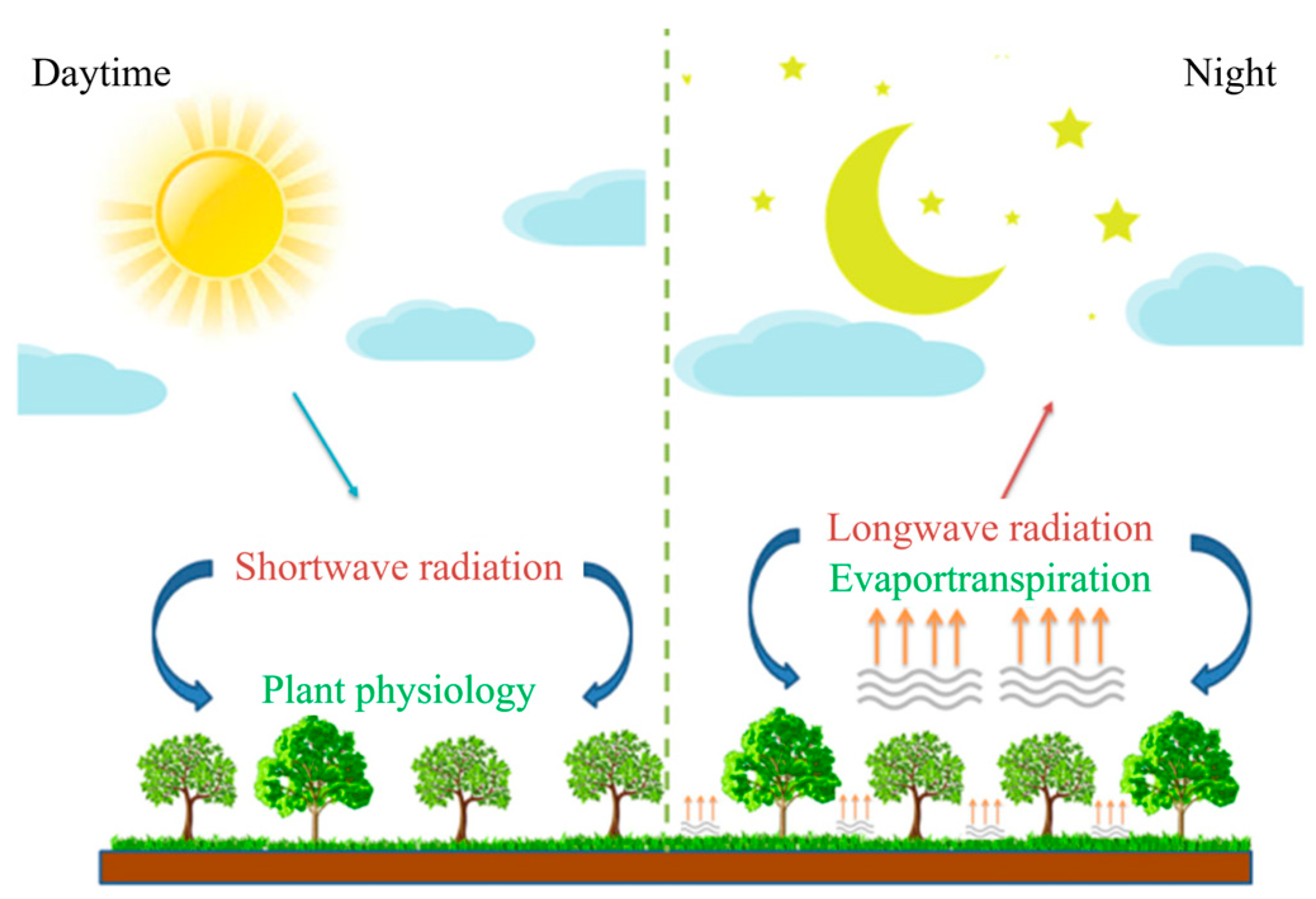

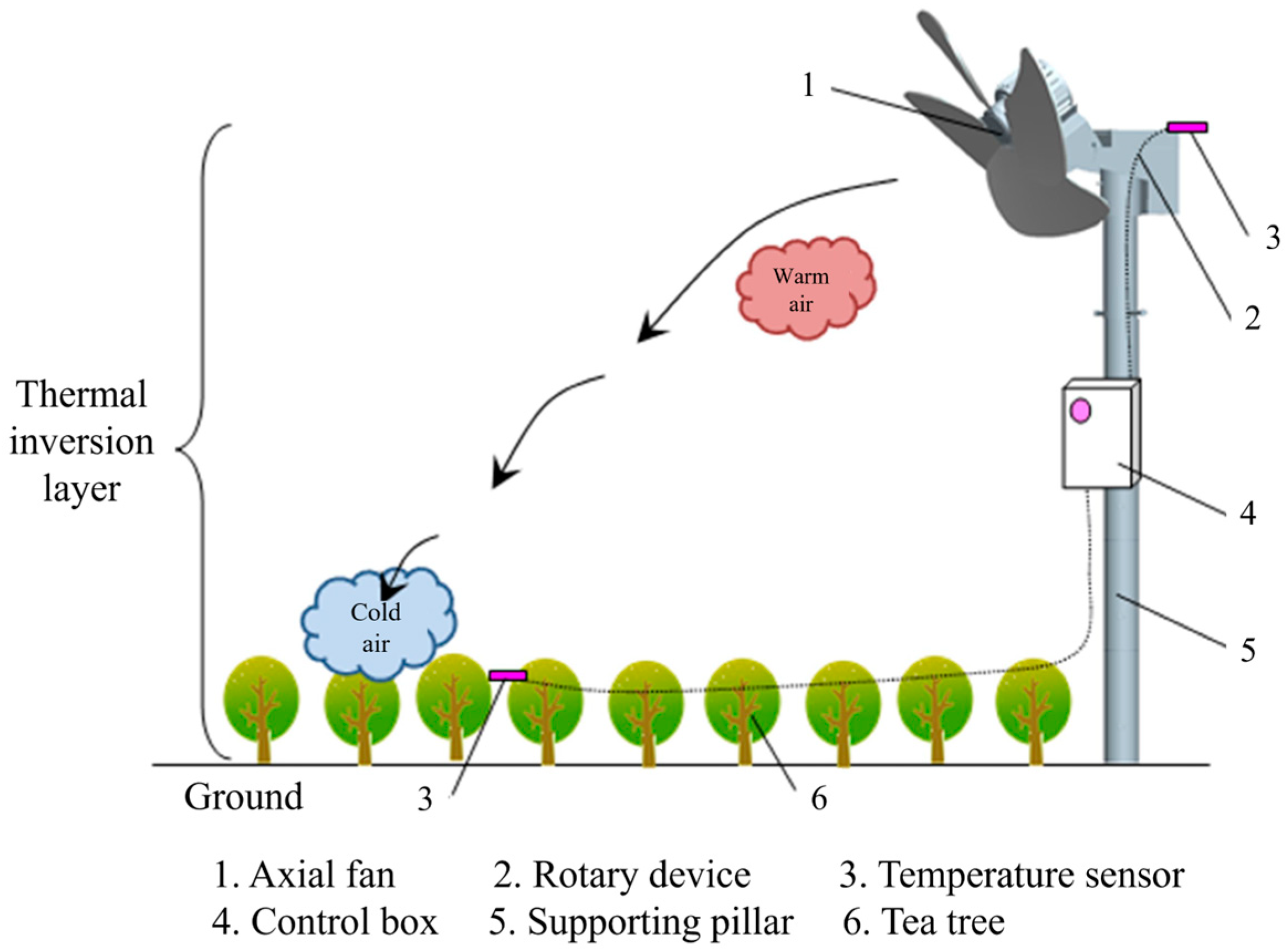

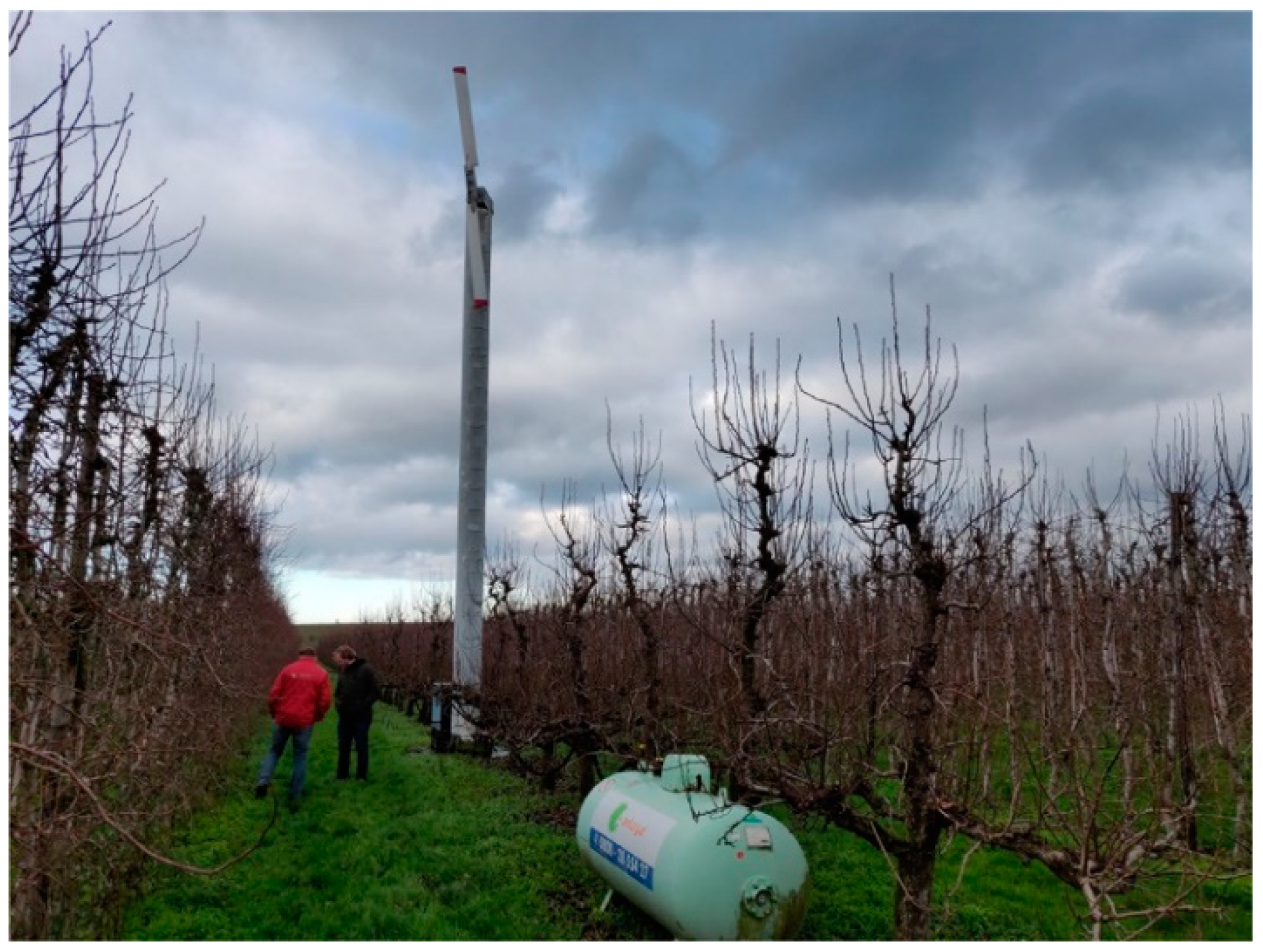
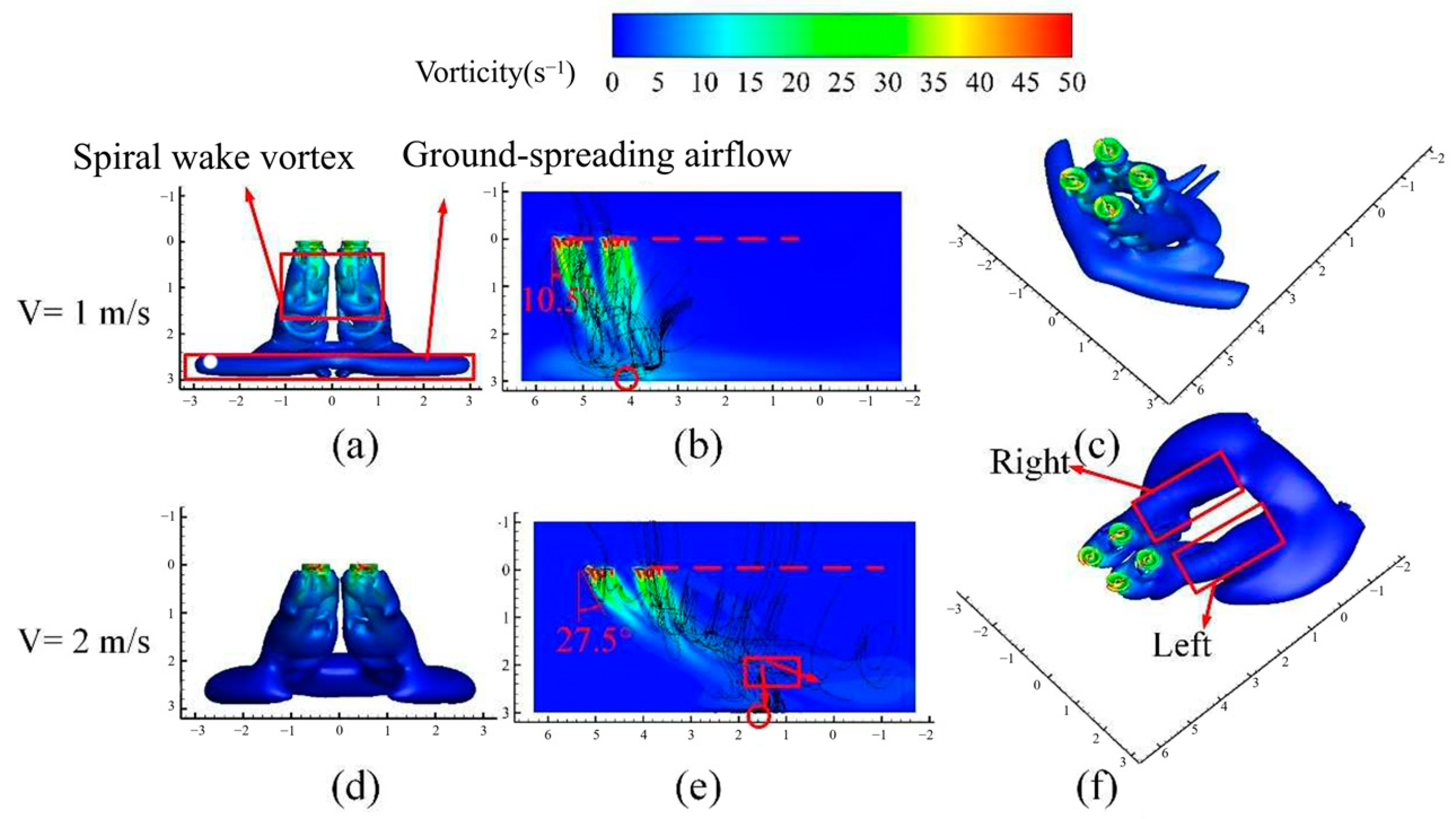
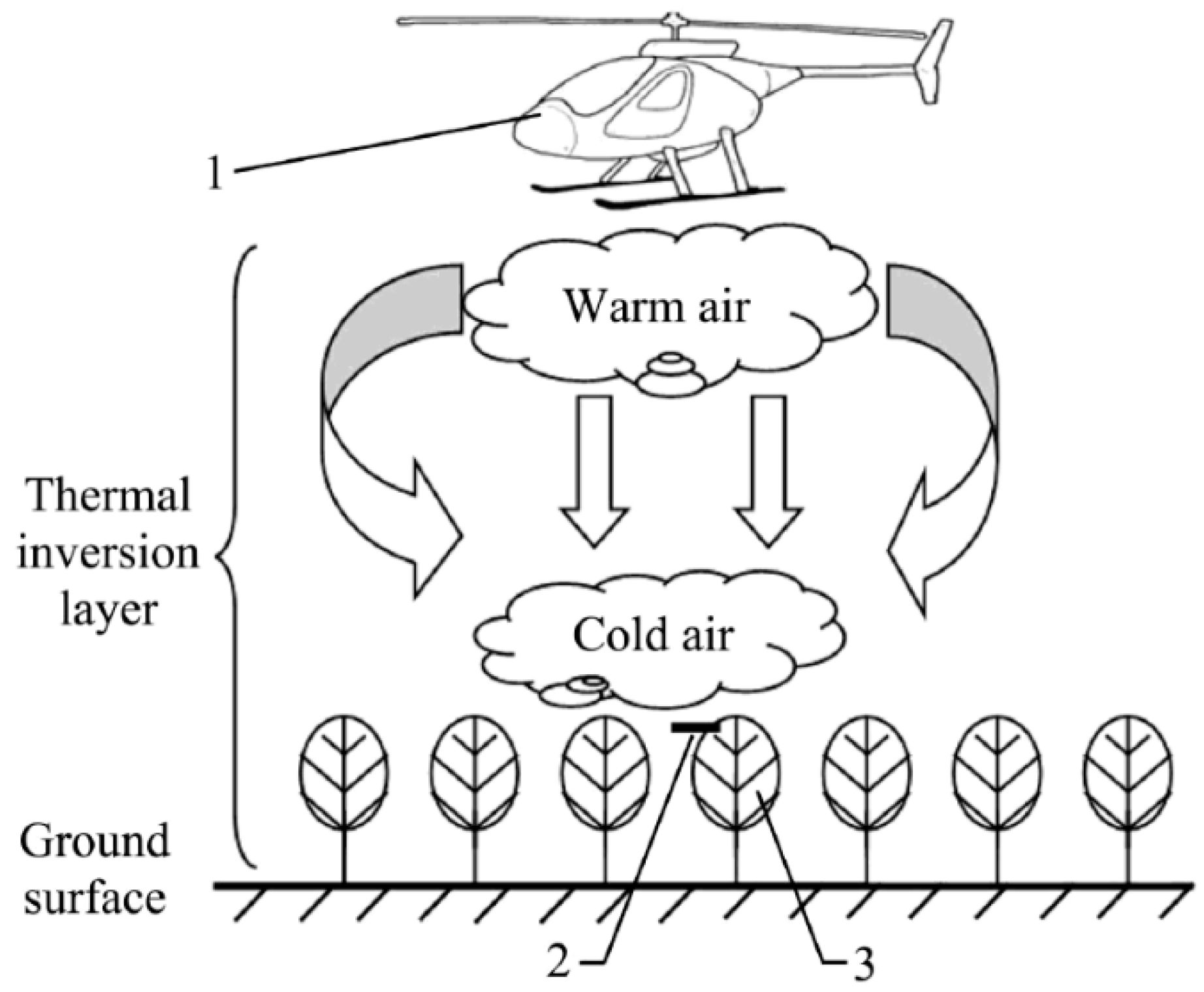
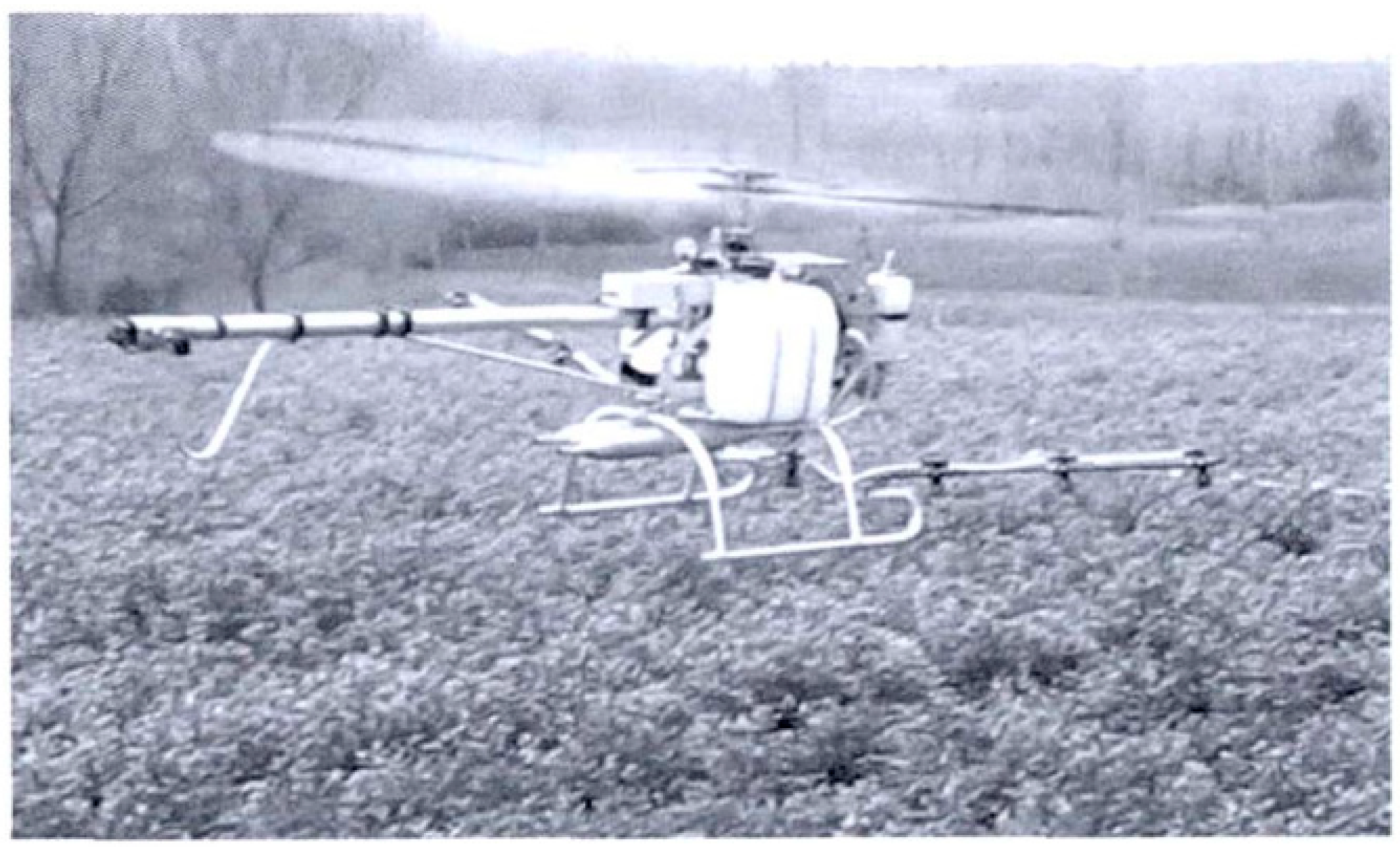

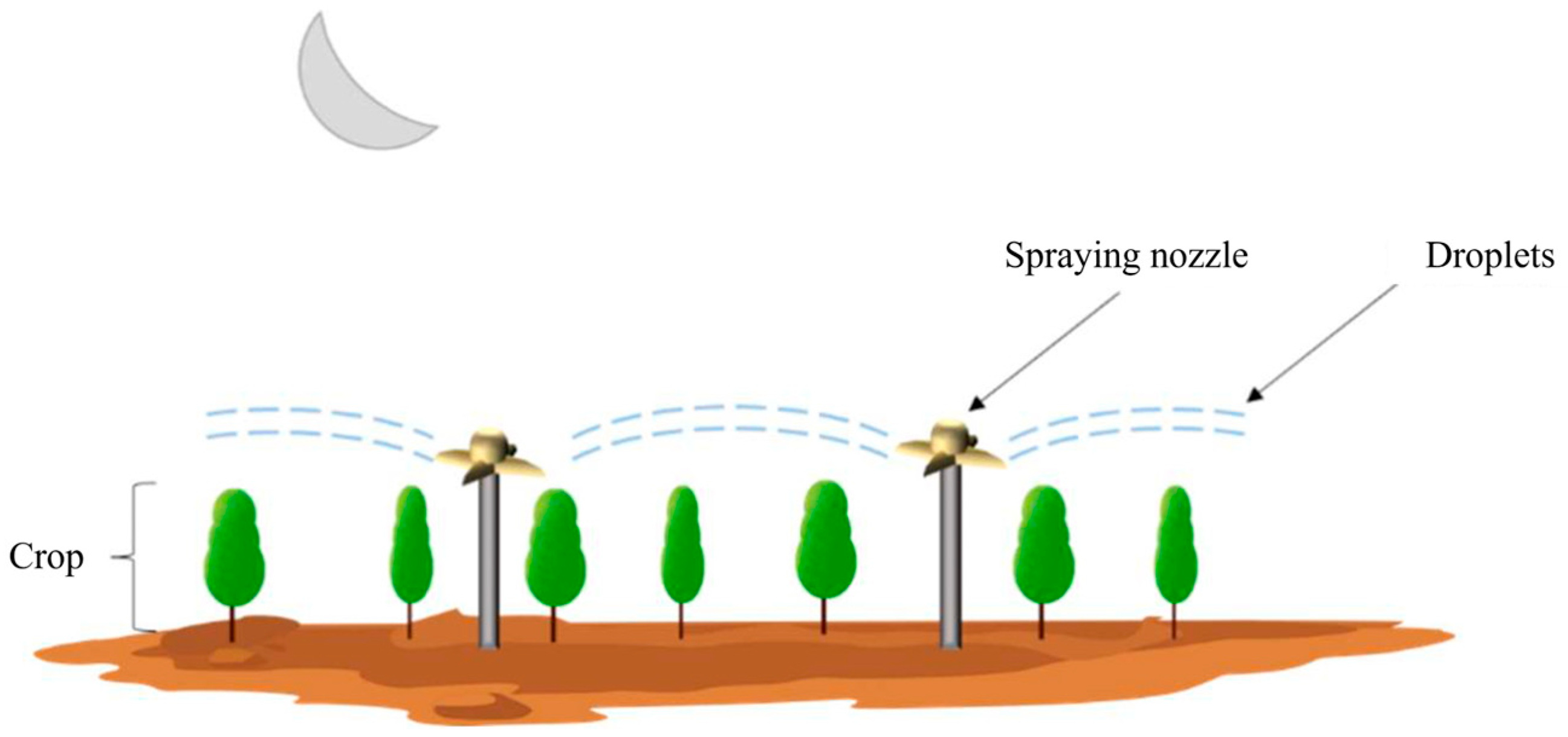
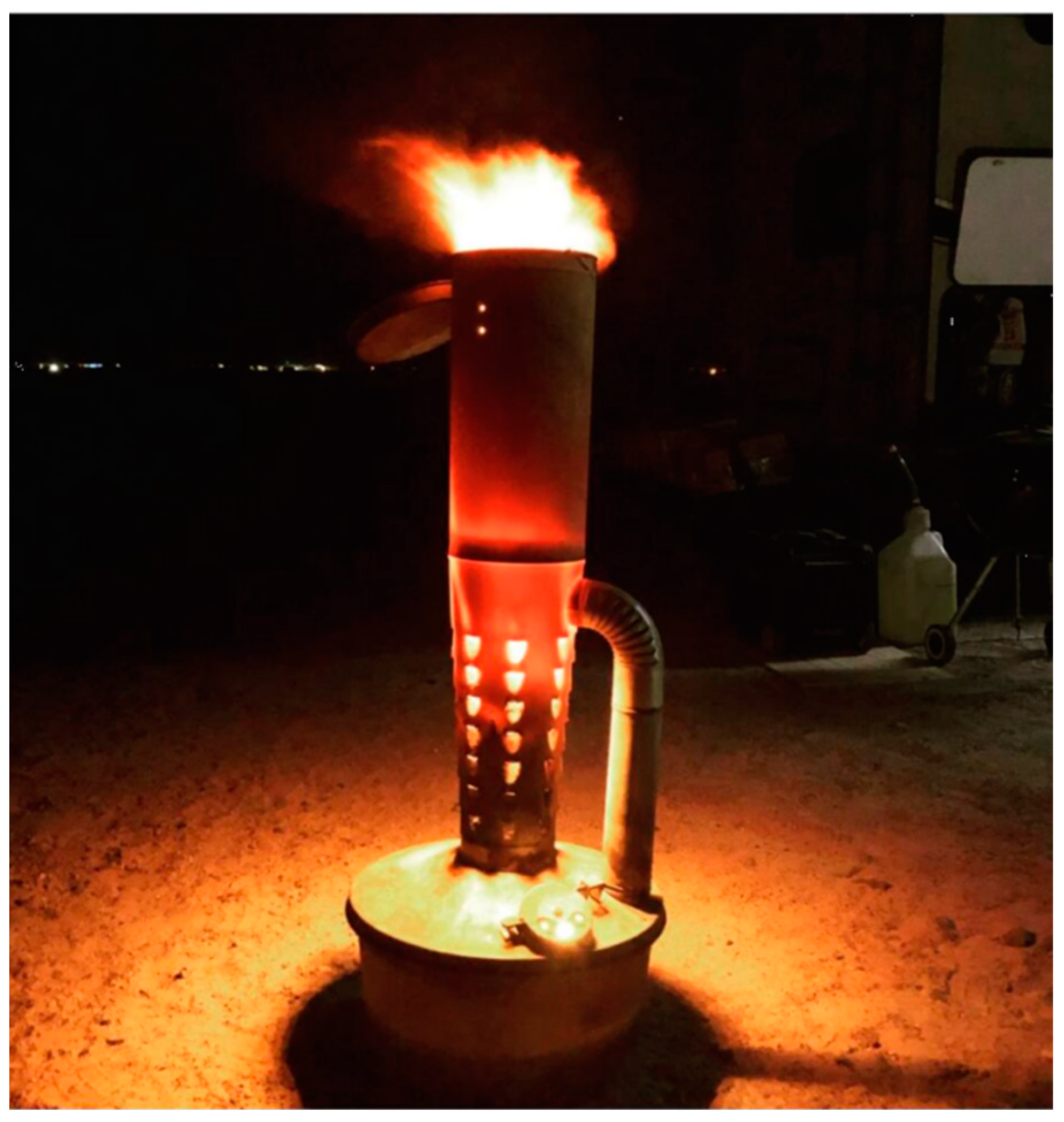
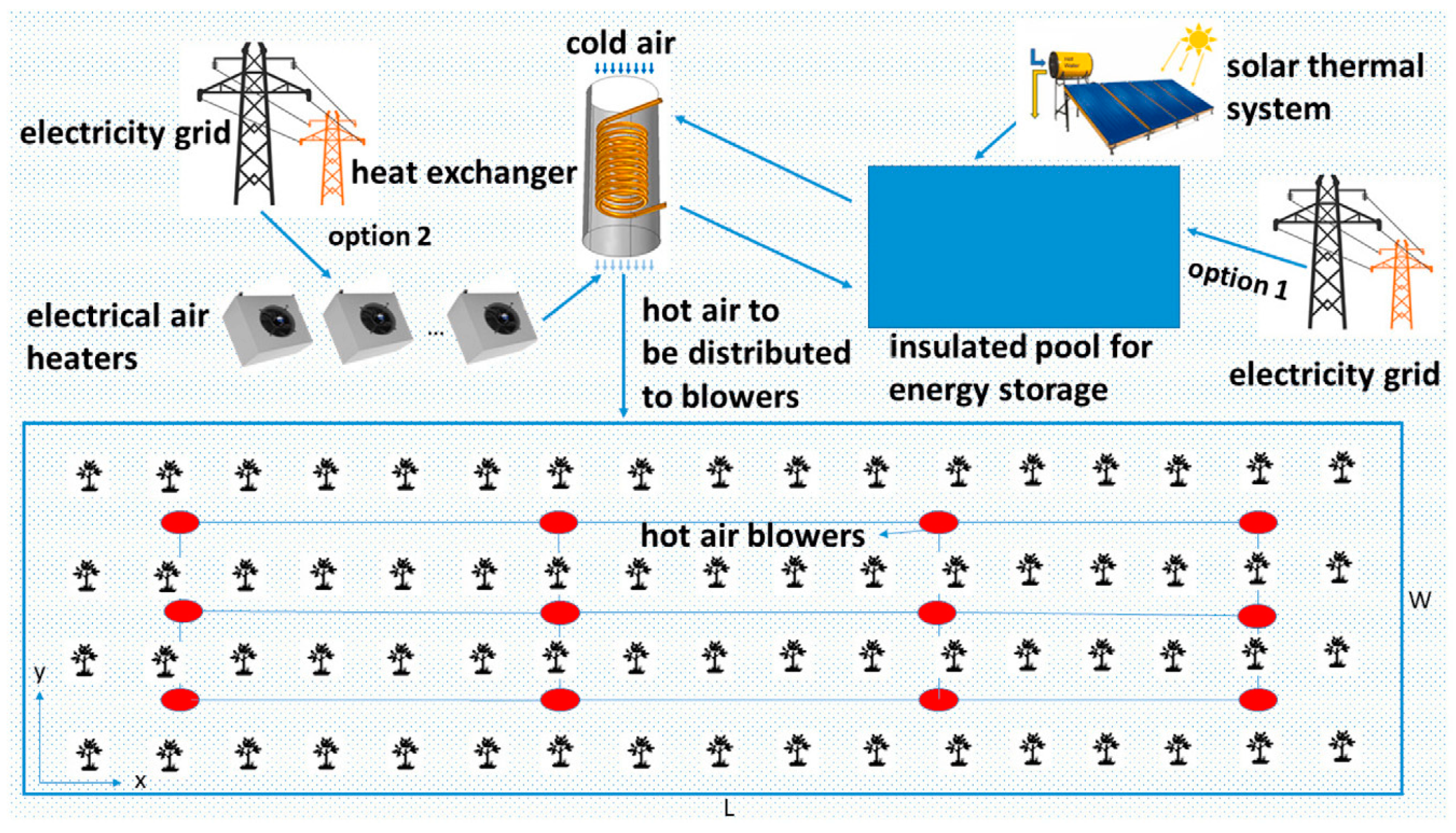
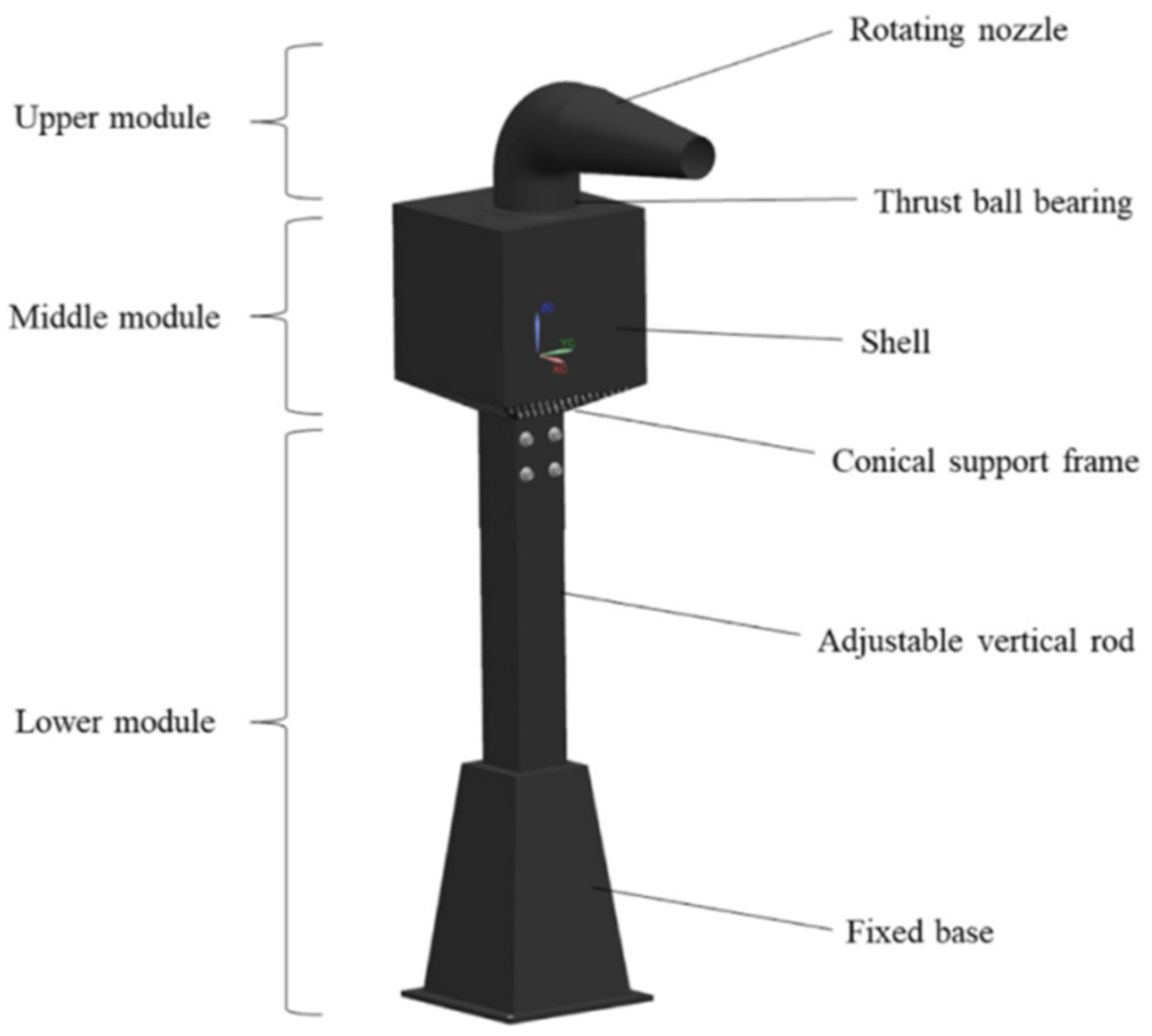

| Method/Equipment | Key Effectiveness Measure | Location | Plant Type | Reference |
|---|---|---|---|---|
| Conventional wind machine | Reduced flower damage by 60% (1999) and 37% (2000); more effective under strong inversion. | Apple orchard, Portugal | Apple | [19] |
| Conventional and upward-suction fans | Conventional fan showed greater temperature increase, especially at 1.1 m under strong inversion. Upward-suction fan had limited effect, potentially negative under weak inversion. | Vineyard, USA | Grapevine | [17] |
| Oscillating anti-freezing fans | Improved thermal balance of tea leaves; more effective under strong inversion. | Tea field, Japan | Tea | [36] |
| Conventional wind machine (field tests and simulations) | Temperature increase at up to 1 m height covered 3–5 hectares; slower rotation (3–6 min) increased affected area; optimal tilt angle between 8° and 16°. | Fruit orchard, the Netherlands | Fruit trees (pear) | [18] |
| Fans (general principles) | Mechanism: mixes air and erodes boundary layer; leaf temperature lags behind air temperature; requires approximately 15 rotations for optimal mixing. | Orchard focus | General | [20] |
| High-altitude fan | 3 kw system: covered over 1000 m2; achieved 4 °C temperature increase at negative 4 °C ambient temperature. | Tea garden, China | Tea | [37,38,39,40,41,42] |
| Large-scale orchard FP machine | 120 kw, 8.5 m height, 6 m blade machine: effective horizontal range of 20–100 m; protected area of 1.73–3.07 hectares per machine. | Orchard, China | Fruit trees | [43] |
| UAV (2012) | Best result: achieved 3.83 °C temperature increase (at 5 m height, 6 m/s speed, 30 min interval). Disturbance effect decreased as height increased (5–10 m). | Tea garden, China | Tea | [46] |
| UAV (2015) | Optimal result: achieved 1.6 °C temperature increase (at 4.0 m height, 6.0 m/s speed, 20 min interval, with 3.8 °C inversion). Parameter influence order: interval > height > speed. | Tea plantation, China | Tea | [30] |
| UAV (DJI T40 Multi-rotor) | Hovering (6 m, 1000 rpm): achieved 2.5 °C to 3.0 °C near-ground temperature increase during critical frost; stabilized temperatures in less than 20 s. | Peach orchard, China | Peach | [29] |
| Method/Equipment | Key Effectiveness Measure | Location | Plant Type | Reference |
|---|---|---|---|---|
| Automatic control (vs. fixed rate) | Provided complete protection using 50% less water than conventional fixed rate. | Fruit orchard | Apple | [47] |
| Heat balance model | Including humidity is crucial; ignoring it can lead to up to 28% underestimation of required rate. | General | General | [48] |
| Micro-sprinkler (over-tree vs. overhead) | Over-tree method maintained peach buds above lethal temperature; used 50% to 87% less water and energy compared to traditional overhead method. | Peach orchard | Peach | [49] |
| Automatic cycling (vs. continuous) | Reduced average water consumption by approximately 72% in three frost events compared to continuous sprinkling. | Apple orchard, USA (PA) | Apple | [50] |
| Automatic system (humidity/temperature-based) | Maintained peach blossom temperature 2.5 °C higher than control; reduced blossom mortality by 29.5%, with 54.3% less water. | Peach orchard, Iran | Peach | [22] |
| Simplified water film model | Determined required irrigation frequency to maintain water film and prevent temperature dropping below 0 °C. | Theoretical | Citrus | [52] |
| Automatic cyclic system (vs. continuous) | Reduced seasonal water use by 33% to 80% (113 to 198 mm saved); yield often higher than with traditional continuous frost irrigation. | Cranberry bog, USA | Cranberry | [53] |
| Ground irrigation (pre-frost/bloom) | Increased air temperature and humidity, reducing frost damage to flower clusters. | Apple orchard, China (Ningxia) | Apple | [54] |
| Continuous spraying (2–4 mm/h) | Maintained tea canopy near 0 °C; post-sunrise temperature rise slowed (+2.2 °C/h vs. +4.8 °C/h in non-irrigated), preventing potential damage. | Tea field, China | Tea | [55] |
| Micro-sprinkler vs. rocker-arm | Micro-sprinkler led to storage of 1.2 times more water and 2.0 times more ice; sprinkling duration significantly increased maximum ice storage, but not maximum water storage. | Tea field, China | Tea | [56] |
| Method/Equipment | Key Effectiveness Measure | Location | Plant Type | Reference |
|---|---|---|---|---|
| Hybrid green energy system | Optimized layout reduced pipeline length by 24.13% and improved heating efficacy by 54.29% compared to heuristic design. | Horticulture | General | [23] |
| Intelligent orchard FP machine | Covered 10 m radius effectively, even with 2 m/s wind; dynamic adaptation; potential for solar power integration. | Mountainous orchard | Fruit trees | [24] |
| Fixed air heaters | VPPC achieved was 32.2%; positioning heaters upwind was better than downwind. Reducing interaction between heaters improved performance. | Apple orchard | Apple | [57] |
| Mobile air heaters | Increased VPPC by 1180.0% compared to heaters at one end, and 141.5% compared to heaters at middle/other end. | Apple orchard | Apple | [57] |
| Precision heating strategy | Number of heaters required was 96.8% less than that of traditional fixed type and 85.9% less than that of traditional mobile type. | Apple orchard | Apple | [58] |
| Method | Initial Investment | Annual Operating Cost | Key Cost Drivers | Manufacturer |
|---|---|---|---|---|
| Wind machines | $3000–$7000+ | $100–$600+ | Initial investment: high equipment cost Operating costs: electricity and maintenance | Orchard-Rite (Yakima, WA, USA) [73] Tow and Blow (Hawke’s Bay, NZ, USA) [74] |
| Sprinkler irrigation | $1500–$5000+ | $150–$800+ | Initial investment: highly dependent on water source Operating costs: mainly pumping energy and potentially water costs | Nelson Irrigation (Walla Walla, WA, USA) [75] Rain Bird (Azusa, CA, USA) [76] |
| Heaters | —— | $500–$2500+ | Initial investment: requires many units Operating costs: primarily fuel, extremely high | Often involve local integrators rather than single global brands |
| UAV | $1500–$6000+ | $50–$400+ | Initial investment: relatively high, but a UAV can achieve multiple functions with a single machine Operating costs: mainly electricity for charging | DJI (Shenzhen, China) [77] XAG (Guangzhou, China) https://www.xag.cn/ [78] |
Disclaimer/Publisher’s Note: The statements, opinions and data contained in all publications are solely those of the individual author(s) and contributor(s) and not of MDPI and/or the editor(s). MDPI and/or the editor(s) disclaim responsibility for any injury to people or property resulting from any ideas, methods, instructions or products referred to in the content. |
© 2025 by the authors. Licensee MDPI, Basel, Switzerland. This article is an open access article distributed under the terms and conditions of the Creative Commons Attribution (CC BY) license (https://creativecommons.org/licenses/by/4.0/).
Share and Cite
Liu, T.; Zhang, S.; Sun, T.; Ma, C.; Xue, X. Review of Active Plant Frost Protection Equipment and Technologies: Current Status, Challenges, and Future Prospects. Agronomy 2025, 15, 1164. https://doi.org/10.3390/agronomy15051164
Liu T, Zhang S, Sun T, Ma C, Xue X. Review of Active Plant Frost Protection Equipment and Technologies: Current Status, Challenges, and Future Prospects. Agronomy. 2025; 15(5):1164. https://doi.org/10.3390/agronomy15051164
Chicago/Turabian StyleLiu, Tianhong, Songchao Zhang, Tao Sun, Cong Ma, and Xinyu Xue. 2025. "Review of Active Plant Frost Protection Equipment and Technologies: Current Status, Challenges, and Future Prospects" Agronomy 15, no. 5: 1164. https://doi.org/10.3390/agronomy15051164
APA StyleLiu, T., Zhang, S., Sun, T., Ma, C., & Xue, X. (2025). Review of Active Plant Frost Protection Equipment and Technologies: Current Status, Challenges, and Future Prospects. Agronomy, 15(5), 1164. https://doi.org/10.3390/agronomy15051164








